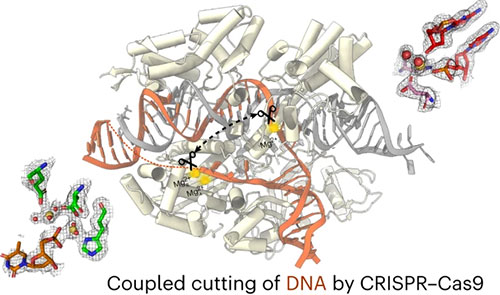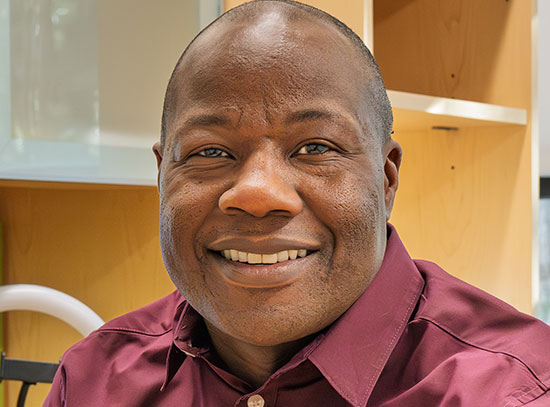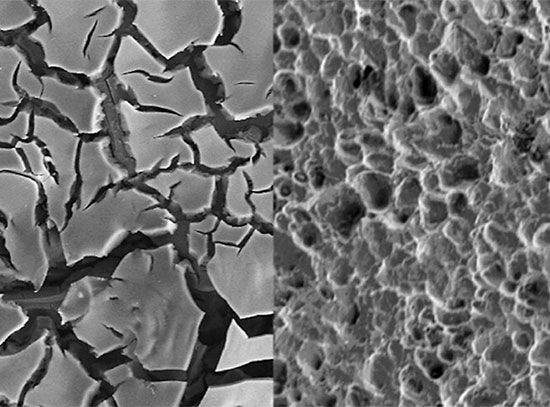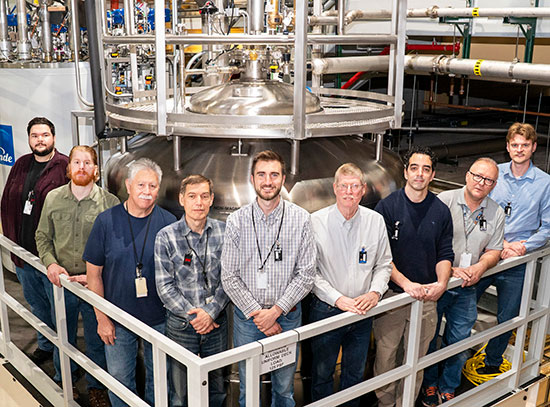First Time-Lapsed Images of Coupled-Cutting of DNA
April 10, 2024
 enlarge
enlarge
An illustration showing the CRISPR-Cas9 enzyme performing near-simultaneous cutting of two strands of DNA.
The Science
Scientists captured time-lapsed images of the CRISPR-Cas9 enzyme performing a near-simultaneous cutting of both strands of DNA.
The Impact
Understanding the catalytic reaction that drives CRISPR-Cas9’s function could yield new tools for gene editing technologies.
Summary
Scientists at Florida State University (FSU) have successfully captured high-resolution images showcasing the interactions between magnesium ions and the gene-editing enzyme CRISPR-Cas9. These images showed the ion’s role in not only breaking chemical bonds but also cutting both DNA strands nearly simultaneously. Cutting both strands almost at once is crucial because if only one strand is broken, the DNA can repair itself quickly without the edits being made.
This breakthrough offers a detailed glimpse into the molecular mechanisms underlying CRISPR's function. By utilizing cutting-edge imaging techniques like Cryo-Electron Microscopy (Cryo-EM), available at Florida State University’s Biological Science Imaging Resource and the Laboratory for BioMolecular Structure at Brookhaven National Laboratory, the team was able to observe magnesium ions guiding the CRISPR enzyme as it precisely edits genetic material, a crucial step in understanding and potentially enhancing the efficacy of this revolutionary gene-editing technology.
This research not only provides unprecedented insights into CRISPR's activity but also lays the foundation for further advancements in gene-editing technologies. By unraveling the molecular intricacies of CRISPR's interaction with magnesium ions, scientists can potentially fine-tune the editing process, enhancing its accuracy and efficiency. This achievement marks a significant step forward in the quest to harness CRISPR's potential for addressing various genetic disorders and advancing biotechnological applications, promising a future where precise genome editing becomes even more accessible and effective.
Download the research summary slide (PDF)
Related Links
Paper - Coupled catalytic states and the role of metal coordination in Cas9
Contact
Hong Li
Florida State University
hong.li@fsu.edu
Publications
Anuska Das, Jay Rai, Mitchell O. Roth, Yuerong Shu, Megan L. Medina, Mackenzie R. Barakat & Hong Li. Coupled catalytic states and the role of metal coordination in Cas9. Nat Catal 6, 969–977 (2023). https://doi.org/10.1038/s41929-023-01031-1
Funding
This work was supported by NIH grant R01 GM101343 to H.L. We also acknowledge the use of instruments at the Biological Science Imaging Resource supported by Florida State University. The Titan was funded from NIH grant S10 RR025080. The BioQuantum/K3 was funded from NIH grant U24 GM116788. The Vitrobot Mk IV was funded from NIH grant S10 RR024564. The Solaris Plasma Cleaner was funded from NIH grant S10 RR024564. The DE-64 was funded from NIH grant U24 GM116788. The Laboratory for BioMolecular Structure is supported by the DOE Office of Biological and Environmental Research (KP160711).
2024-22396 | INT/EXT | Newsroom









